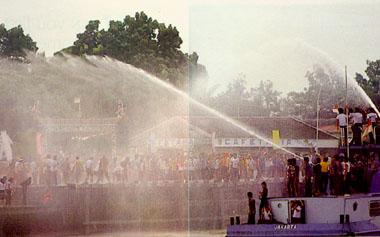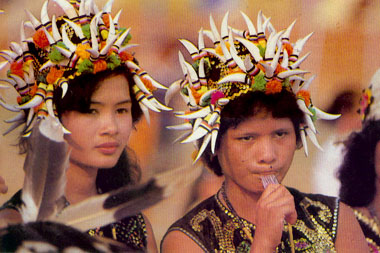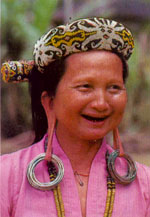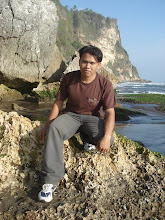A PORTION OF BORNEO
To most European and Americans, the name "Kalimantan" rings no bells. Borneo might just bring up a vague recollection from a geography class. The coasts of this huge island (which used to be known only as Borneo) were colonized by the Dutch and the British. After Indonesia won independence from Holland, its portion of the island was named Kalimantan. This "new" name is really ancient, the proper one for at least portions of the island before the arrival of the Europeans. The word "Kalimantan" could come from the name of a fruit or result from the combination of the Malay words meaning "river of diamonds". The name Borneo is a deformation of the sultanate of Brunei which, several centuries ago, controlled a large chunk of territory in the northern part of the island at the time of the arrival of the first Europeans. Geographers still use the name Borneo when referring to the island as a whole.
The former British section, now mostly a part of Malaysia, is divided into the provinces of Sarawak and Sabah plus the tiny, super-rich independent oil sultanate of Brunei.
The Indonesian portion is split into four provinces, named after their geographical positions: Kalimantan Selatan (south), Kalimantan Timur (east), Kalimantan Tengah (central) and Kalimantan Barat (west). The names of these provinces are often abbreviated, as in Kaltim for Kalimantan Timur.
The island of Borneo is the world's third largest, if we exclude Australia. Greenland tops the list with over 2 million square kilometres, followed by New Guinea's 808,000. Borneo weighs in with 743,000. Much of the island is of low altitude (over half of Kaltim's 211,000 square kilometres lies under 150 metres of elevation) with a central spine of mountains. Kalimantan is dominated by three great river systems, the land's essential means of communications: the Kapuas, the longest of the three, flows west to Pontianak; the Barito, the widest, heads south to Banjarmasin and the Mahakam, with the most volume of water runs east to Samarinda. All three rivers flow from the same area, the mountains of the central portion of the island.
East Kalimantan, whose 1.5 million inhabitants - of which some 30% are Dayaks - represents Indonesia's least densely populated province after Irian Jaya. It is also the country's richest, responsible for some 25 of export earnings. These exports are the land's natural resources: oil, natural gas, timber and coal.
The island of Borneo first surfaces in literature through Chinese annals dealing with trade routes and tribute. These pre-Christian era documents give a glimpse of Borneo's gold and exotic oriental pharmaceuticals such as camphor and bezoar stones.
The first written record of Indonesia was discovered in one of the Malay-Hindu kingdoms, Mulawarman, whose capital was Muara Kaman on the lower Mahakam River, at the junction with its first main tributary, the Telen. This kingdom, as others in Sumatra and Java, was strongly influenced by the Hindu culture and religion. At Muara Kaman, sacrificial "yupa" poles of stone, inscribed in the Indian Pallawan script, attest to fourth century AD rituals when thousands of animals were slaughtered. Further inland, off the Telen River, the cave of Goa Kembang was discovered in 1895. It sheltered a dozen Hindu-style stone statues.
The trade with China continued over the centuries, interrupted only by problems and policy changes of the Celestial Kingdom. Fifth century (and later) Chinese records list an expanded number of exotic products from Borneo: gold, diamonds, camphor, birds' nests, aloe wood and the bezoar stones which are hard little spheres found in the gall bladders of certain species of monkeys.
 A free-for-all water fight with jets sweeping everyone in sight. |
KUTAI
Islam arrived from Java in the 15th century and the Mulawarman kingdom of East Kalimantan fused with the Muslim elements, changing the realm's name to Kutai Kartanegara after its Javanese model. Dynastic changes led to the rise of the Sultanate of Kutai which was founded on the banks near the mouth of the Mahakam River.
At the end of the 13th century, Marco Polo reported considerable traffic by junks between China and Borneo. The first European to have landed there was (perhaps) Friar Odoric, around the year 1322, on his way to China. Prior to the conquest of Malacca, the Portuguese might have disembarked on Borneo. They definitely did so after their 1511 takeover of the greatest trading emporium of Southeast Asia. But Portuguese interests were focused on the Spice Islands which are located further east. Pingafetta, the chronicler of Magellan's epic circumnavigation of the earth, describes the splendors of the court at Brunei, in a town which he claims held 25,000 families.
After a combined army of Kutai and Bugis forces repelled an unofficial British military expedition (disguised as a trading mission), the Dutch colonial army took over East Kalimantan to keep England at bay. The sultan was allowed to retain a measure of power as long as he did not interfere with Dutch interests. Late in the 19th century, he granted oil and coal concessions to the Dutch who quickly made these enterprises most profitable. While coal mining was aban-doned after the demise of steam ships, oil production continued to flourish. The modern town of Balikpapan was built for and by oil, the region's black gold. The installations were taken over by the Japanese during WW II, bombed by the Allies, and rebuilt after 1945. Timber, the green gold, started as a major export earner in the 1960s and is responsible for Samarinda's growth. A tremendous liquified natural gas complex at Bontang started production in 1973, shipping its total production to Japanese power companies. Within the last few years, coal mining has geared up again.
 Leopard claws and teeth decorate headdress of Dayak maidens, attired in traditional costume |
THE DAYAKS
Headhunting was one of the main pillars of Dayak culture. In the old days, it was believed that freshly severed heads were essential to the welfare of a village. Old heads' power faded with age and new ones were continuously needed. This led to a permanent state
of warfare in the hinterland of Borneo until the practice was stopped early in this century by the British and Dutch colonial governments.
The Dayaks, who make up some 30% of Kaltim's population, are divided in this province into three main groups: the Kenyah, the Kayan and the Bahau. These in turn are each subdivided into several sub-groups. All Dayaks show a fundamental physical and cultural unity. They are usually light skinned and of Mongol genetic stock.
Several Dayak groups used to excel in beautiful and intricate ironwood carvings with religious significance but this is now fast becoming a lost art. Carvings were a common feature of longhouses in many areas. These huge wooden houses were built on stilts, up to 180 metres long and 18 metres wide. The largest ones boasted of some 200 doors to serve up to 500 persons or 50 families living under one roof. Villages located in several upstream areas of the Mahakam still have longhouses although the government is trying to encourage individual housing.
| |
Many of the older women still sport personal decorations consisting of many large metal rings - weighing up to one kilo per ear - in huge distorted earlobes. Hands and other parts of the body were tattooed to mark status and as a means for ancestors to recognize their descendants after death.
(There are several elements of Dayak mythology and belief with un-canny parallels to the Aztecs and other Indian groups ot ancient Mexico. The feathered serpent was an important figure in both pantheons. There were special paradises, depending on the manner of death. Warriors who died in battle and women who died in childbirth shared one of the paradises in the afterlife. There was another one for those who died by drowning.)
Since the conclusion of WW II, missionaries have succeeded in converting most Dayaks to the Catholic or Protestant faiths. Traditional beliefs have been abandoned, except in a few remote areas. Christianity has been accepted over Islam mostly because it allows the consumption of pork and the presence of dogs which are invaluable for hunting wild game.***






0 komentar:
Posting Komentar